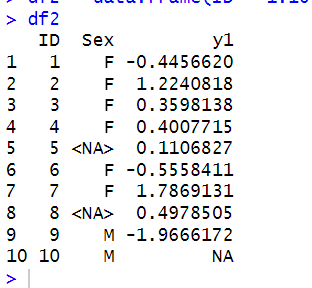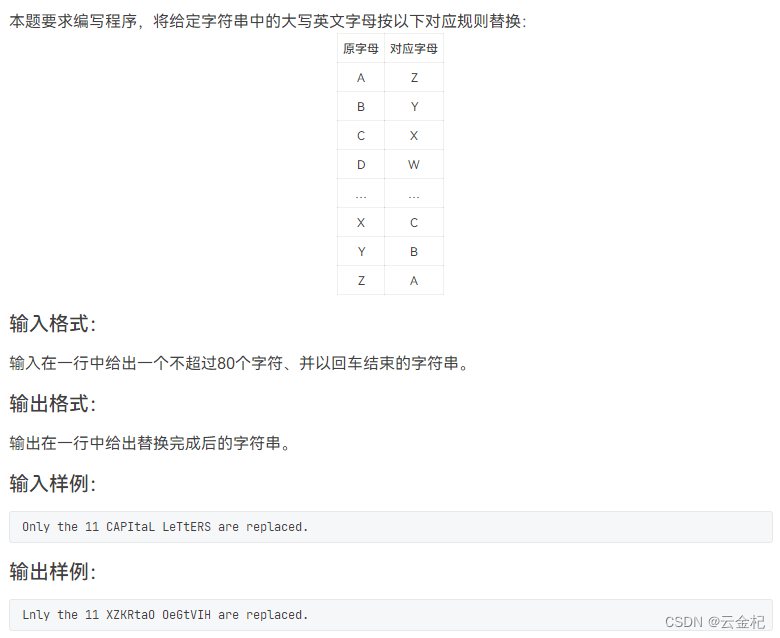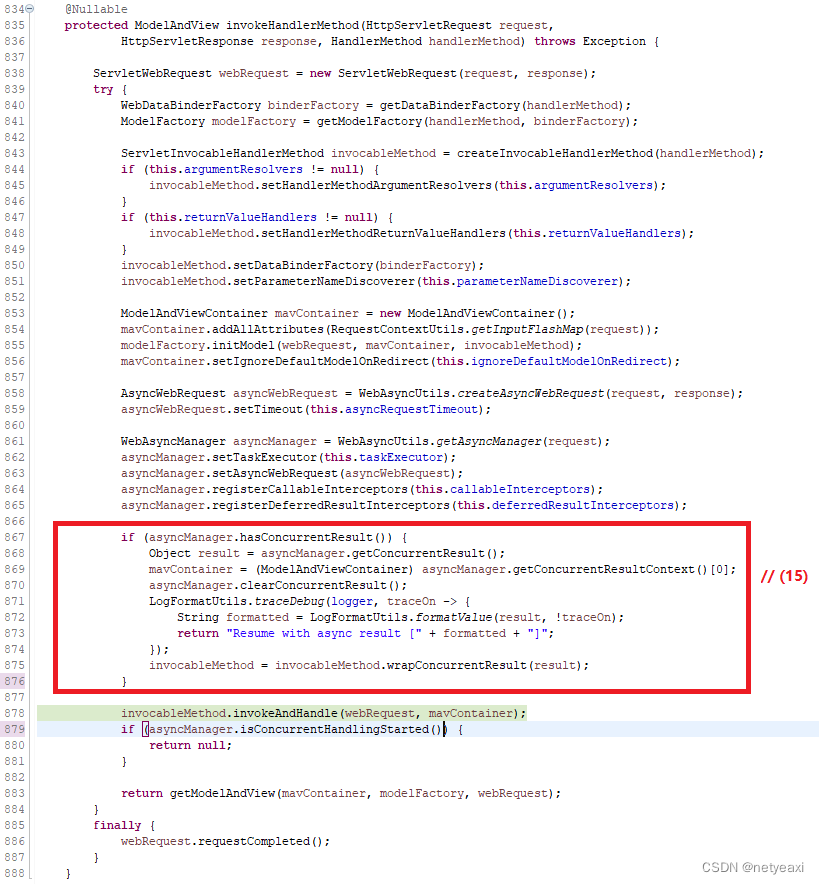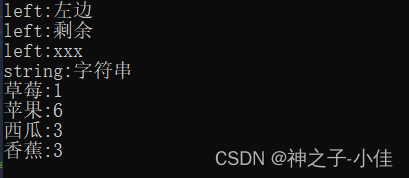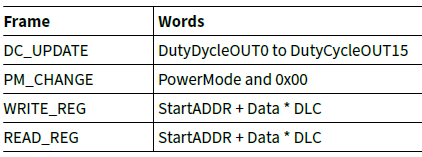目录
1.函数对象
1.1函数对象的概念
1.2函数对象的使用
2.谓词
2.1谓词概念
2.2一元谓词
2.3二元谓词
3.内建函数对象
3.1内建函数对象的意义
3.2算术仿函数
3.3关系仿函数
3.4逻辑仿函数
1.函数对象
1.1函数对象的概念

1.2函数对象的使用

#include<iostream>
using namespace std;
//函数对象(仿函数)
class MyAdd
{
public:
int operator()(int v1,int v2)//可以有参数,可以有返回值
{
return v1 + v2;
}
};
//1.函数对象在使用时可以像普通函数那样调用,可以有参数,可以有返回值
void test01()
{
MyAdd myadd;
cout << myadd(10, 10) << endl;
}
//2.函数对象超出普通函数的概念,函数对象可以有自己的状态
class MyPrint
{
public:
MyPrint()
{
count = 0;
}
void operator()(string test)
{
cout << test << endl;
count++;//记录函数调用几次
}
int count;//内部自己的状态
};
void test02()
{
MyPrint myprint;
myprint("hello world");
myprint("hello world");
myprint("hello world");
myprint("hello world");
cout << "MyPrint调用次数为:" << myprint.count << endl;
}
//3.函数对象可以作为参数向一个函数中传递
void doPrint(MyPrint& mp, string st)
{
mp(st);
}
void test03()
{
MyPrint myprint;
doPrint(myprint, "hello c++");
}
int main()
{
test01();
test02();
test03();
system("pause");//按任意键继续
return 0;
}
仿函数写法灵活,没有一个固定的写法
2.谓词
2.1谓词概念

2.2一元谓词
#include<iostream>
using namespace std;
#include<vector>
//谓词
class GreaterFive
{
public:
bool operator()(int val)//遍历[v.begin(),v.end())这个区间时,每次都拿一个数
{
return val > 5;
}
};
void test01()
{
vector<int>v;
for (int i = 0; i < 10; i++)
{
v.push_back(i);
}
//查找容器中有没有大于5的数字
vector<int>::iterator it = find_if(v.begin(), v.end(), GreaterFive());//区间,第三个是谓词,需传入函数对象
//GreaterFive()匿名函数对象
//GreaterFive()不写成GreaterFive()()调用小括号是因为,find_if定义里调了小括号()
// find_if返回一个迭代器,找到了就返回这个位置的迭代器,找不到就返回end位置的迭代器
if (it == v.end())
{
cout << "未找到到" << endl;
}
else
{
cout << "找到了大于5的数字为:" << *it << endl;
}
}
int main()
{
test01();
system("pause");//按任意键继续
return 0;
}
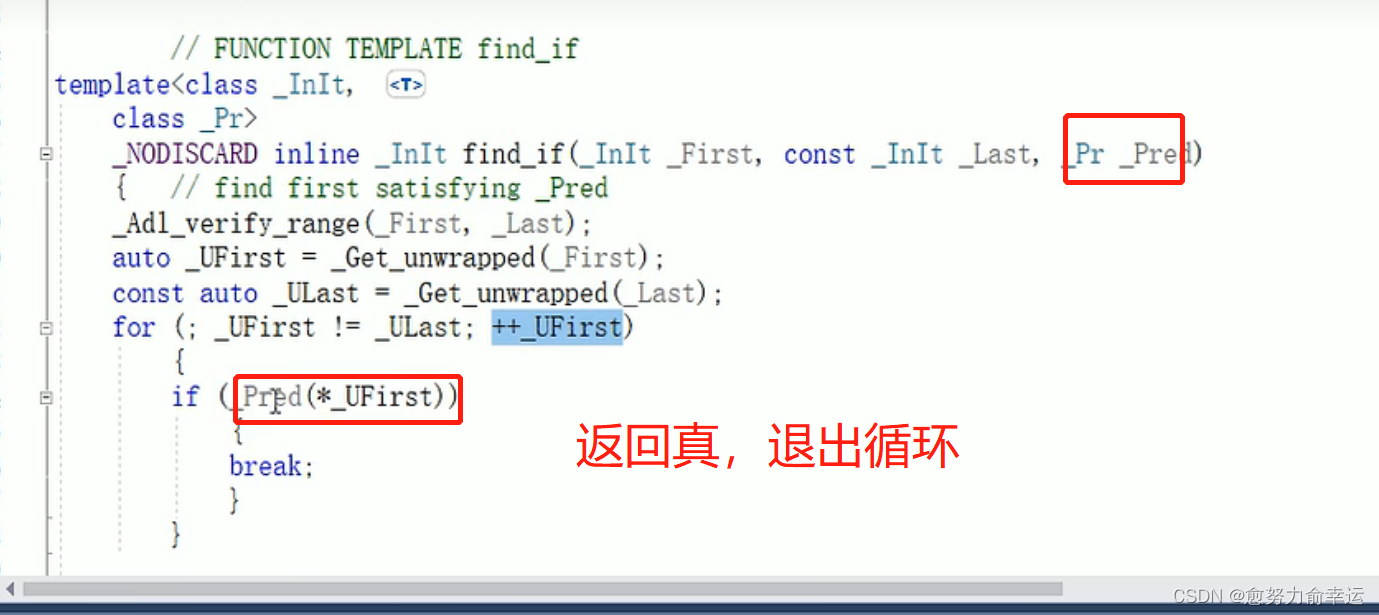
2.3二元谓词
#include<iostream>
using namespace std;
#include<vector>
#include<algorithm>
//二元谓词
class MyCompare
{
public:
bool operator()(int val1,int val2)
{
return val1 > val2;
}
};
void test01()
{
vector<int>v;
v.push_back(10);
v.push_back(40);
v.push_back(20);
v.push_back(30);
v.push_back(50);
sort(v.begin(), v.end());
for (vector<int>::iterator it = v.begin(); it != v.end(); it++)
{
cout << *it << " " ;
}
cout << endl;
//使用函数对象 改变算法策略,变为排序规则从大到小
sort(v.begin(), v.end(), MyCompare());
cout << "~~~~~~~~~~~~~~~~~~~~~~~`" << endl;
for (vector<int>::iterator it = v.begin(); it != v.end(); it++)
{
cout << *it << " ";
}
cout << endl;
}
int main()
{
test01();
system("pause");//按任意键继续
return 0;
}
3.内建函数对象
3.1内建函数对象的意义
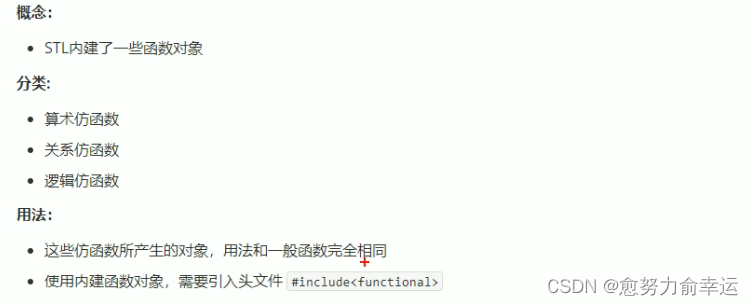
3.2算术仿函数
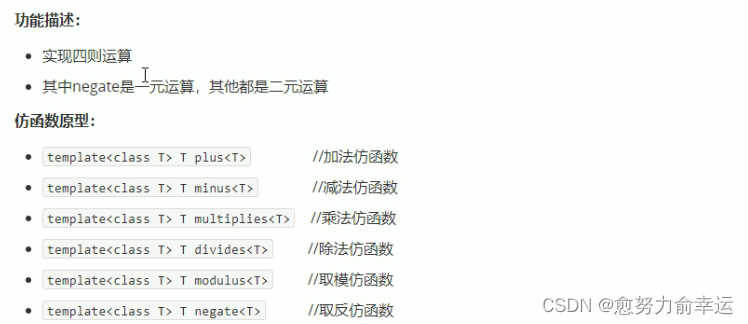
#include<iostream>
using namespace std;
#include<functional>
//内建函数对象 算术仿函数
//negate 一元仿函数 取反仿函数
void test01()
{
negate<int>n;//对整型取反
cout << n(50) << endl;//相当于对50进行取反操作
//输出:-50
}
//plus 二元仿函数 加法
void test02()
{
plus<int>p;//默认传的都是同一个类型,所以只需要写一个int
cout << p(10, 20) << endl;
//输出:30
}
int main()
{
test01();
test02();
system("pause");//按任意键继续
return 0;
}
3.3关系仿函数
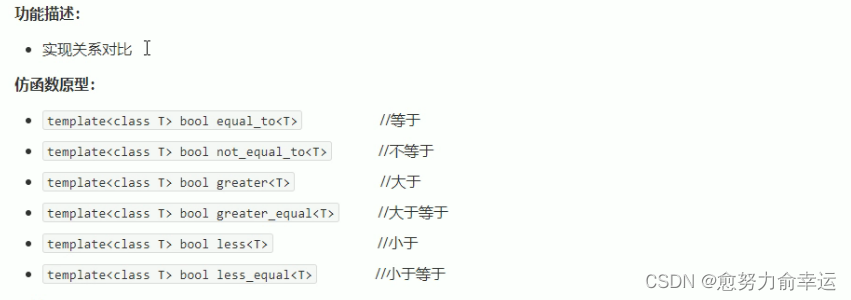
#include<iostream>
using namespace std;
#include<vector>
#include<algorithm>
#include<functional>
//内建函数对象 关系仿函数
//大于 greater
void test01()
{
vector<int>v;
v.push_back(10);
v.push_back(30);
v.push_back(40);
v.push_back(20);
v.push_back(50);
for (vector<int>::iterator it = v.begin(); it != v.end(); it++)
{
cout << *it << " ";
}
cout << endl;
//降序
sort(v.begin(), v.end(), greater<int>());//对int类型降序
cout << "@@@@@@@@@@@@@@@@@@@@@@@@" << endl;
for (vector<int>::iterator it = v.begin(); it != v.end(); it++)
{
cout << *it << " ";
}
cout << endl;
}
int main()
{
test01();
system("pause");//按任意键继续
return 0;
}
3.4逻辑仿函数

#include<iostream>
using namespace std;
#include<vector>
#include<algorithm>
#include<functional>
//内建函数对象 逻辑仿函数
//逻辑非 logical_not
void test01()
{
vector<bool>v;
v.push_back(true);
v.push_back(false);
v.push_back(true);
v.push_back(false);
for (vector<bool>::iterator it = v.begin(); it != v.end(); it++)
{
cout << *it << " ";
}
cout << endl;
//利用逻辑非 将容器v 搬运到 容器v2中, 并执行取反操作
vector<bool>v2;
v2.resize(v.size());//开辟空间,然后搬运
transform(v.begin(), v.end(), v2.begin(),logical_not<bool>());//原容器的起始迭代器,原容器的结束迭代器,目标容器的起始迭代器,仿函数
//搬运期间将数进行一些操作
//logical_not<bool>(),bool是因为我们是bool的类型
for (vector<bool>::iterator it = v2.begin(); it != v2.end(); it++)
{
cout << *it << " ";
}
cout << endl;
}
int main()
{
test01();
system("pause");//按任意键继续
return 0;
}
逻辑仿函数应用较少,了解即可
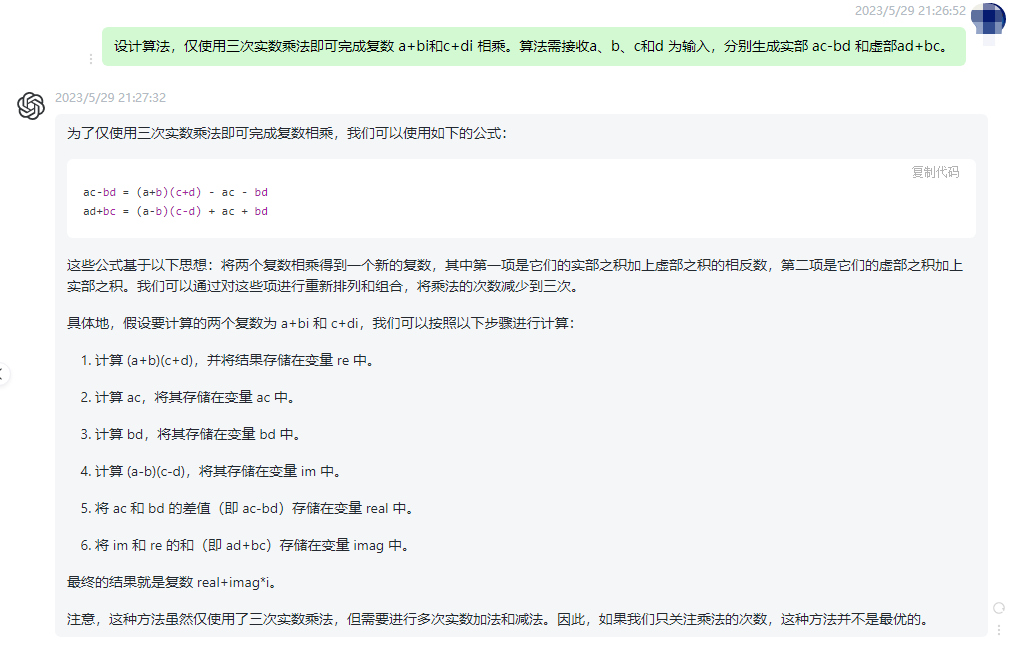


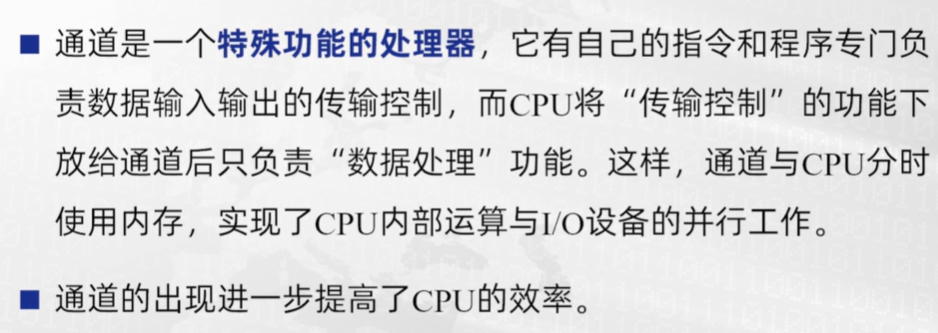

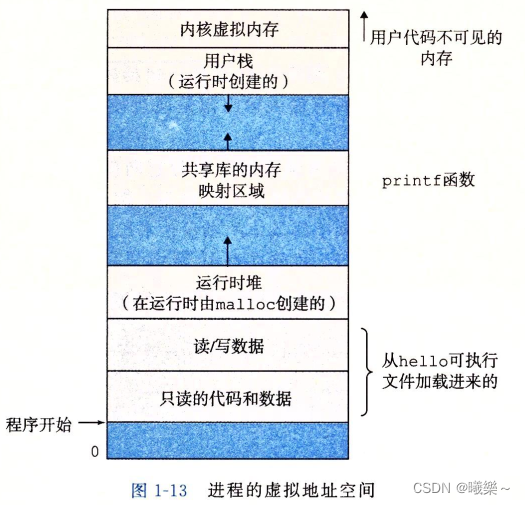


![【群智能算法改进】一种改进的沙丘猫群优化算法 改进沙丘猫群算法 改进SCSO[1]【Matlab代码#34】](https://img-blog.csdnimg.cn/e95879a529e04ce796e80c5913678e4d.png#pic_center)




